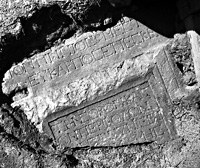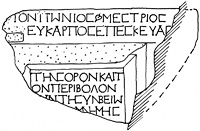 MAMA XI 283 (Northern Lykaonia)
MAMA XI 283 (Northern Lykaonia) 
Sarcophagus of Pomponius Mestrius Eukarpos
- Type of monument:
- Sarcophagus fragment.
- Location:
- Zengicek (Koçyaka) (Northern Lykaonia): in a house-wall.
- Description:
- Grey marble fragment of sarcophagus with tabula ansata. Broken on all sides.
- Dimensions:
- Ht. 0.42+; W. 0.72+; Th. --; letters 0.025-0.030.
- Record:
- Line drawing; MB notebook copy; photograph (1956/131).
- Publication:
- None.
- Date:
- Second or third century AD.
Π̣ονπώνιος hed. Μέστριος hed.
Εὔκαρπος ἐπεσκεύασεν̣
τὴν σορὸν καὶ τ-
ὸν περίβολον
5[σ]ὺν τῇ συνβείῳ
[αὐτο]ῦ̣ μνήμης
[χάριν].
Pomponius Mestrius Eukarpos constructed the sarcophagus and the enclosure along with his wife, in memoriam.





Pomponius Mestrius Eukarpos carried two gentilicia, both of which are highly characteristic of Ikonion. The earliest known Pomponii at Ikonion are M. Ulpius Pomponius Superstes and his father M. Ulpius Pomponius Valens, who appear in a Latin inscription dating to the reign of Hadrian (ILS 9414). M. Ulpius Pomponius Superstes is described as princeps and IIvir primus coloniae, reflecting the amalgamation of the Roman colony at Ikonion with the native community under Hadrian (Mitchell 1979a: 411-25). The nomenclature of M. Ulpius Pomponius Valens shows that he received the Roman citizenship through T. Pomponius Bassus (PIR2 P 705), governor of Cappadocia-Galatia AD 94-100 (Mitchell 1979a: 413). At an uncertain date, probably in the later second century AD, civic officials by the names of Pomponius Claudianus and Aelius Vibius Pomponianus Aquila are found at Ikonion (Calder 1912a: 75-7, no. 48; Robert, Hellenica XIII, 248-52); a Pomponianus Quadratus is found as a member of an Ikonian delegation to Claros around AD 140 (Macridy 1905: 168-9, no. IV/V, 2; for the date, the 65th prytany of Apollo, see Robert and Robert 1954: 213-4); later tombstones from Ikonion give the names of Λόυκιος Πομπώνιος Ἱπποκράτης (I.Konya 105) and Λ. Πονπώνι̣[ος - -]λιων (I.Konya 162). The nomen also appears in a Late Antique funerary inscription from Laodikeia Katakekaumene (Ramsay 1888: 238-9, no. 11; Robert 1963: 50: Καλ(πουρνία) Πονπωνία Παυ(λείνα)).
Two Mestrii are also known at Ikonion: in the Augustan period, P. Mestrius P.f. Maecianus (Cronin 1902: 356, no. 111), and in the fourth century AD, a woman named Mestriane (Sterrett 1888a: 211, no. 231). A woman with the gentilician Mestria is found at the neighbouring village of Akçaşar (MAMA XI 280 [1956/156]). Two Mestrii appear in a Clarian delegation list of an unnamed city (Macridy 1905: 165-6, no. II, 4). The onomastics of the delegates – all Roman citizens, carrying the nomina Mestrius, Aelius and Herennius (cf. CIG 4001; Cronin 1902: 340, no. 60, both from Ikonion) – suggest that the city concerned is very likely to be Ikonion.